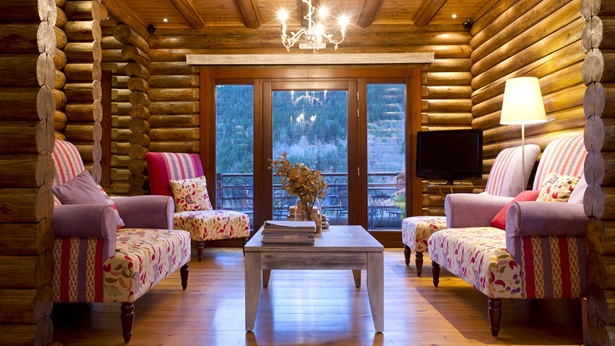Determine Your Budget
Dial in Your Finances Before Evaluating Designs or Comparing Log and Timber Home Producers
If you’ve purchased a conventional home before, among the real estate agent’s first questions will be: “What price range can you afford?” Buying and building a new log or timber home is no different. You have to establish a ballpark budget. This will allow you to move forward on The Perfect Path to Your Dream Home.
If you’re like most people, the winning Lotto ticket has escaped your grasp and you will have to finance this project.
The Great News: Low Interest Rates
Although they are starting to inch up in 2014, mortgage rates are still at historic lows. Those rates are providing an incentive for buyers. The Federal Reserve is considered to be mostly responsible for this rate tranquility, because it has been buying most of the mortgage-backed securities that have been issued in the last year.
More Great News: Land is Affordable
Land is affordable as never before. Before the housing boom went bust, land costs were as much as 60% -80% percent of the total cost of a new home in some markets in the United States (the average was 25%). Now, depending on the region, that percentage has fallen into the single digits. In places like Atlanta, GA and Cleveland, OH, land costs have fallen 30% to 40%, respectively. If you’re thinking deals can be had, you’d be right. Read our How to Locate Land tip in our Buyers Guide.
Not So Good News: Changes in Lending Requirements
That same boom-bust cycle has altered just about everything about lending requirements for all new home construction (not just log or timber construction). Among them:
- Credit Score: Greater than 700
Not only will your score need to be 700 or higher, your three digit credit score will also help determine the interest rate you’ll pay, says Greg Ebersole, loan production manager at American Log Mortgage. (If you need financing for your new home email Greg: [email protected] or call (717) 285-6605.) - Boost Your Score
If you want to boost your score, sign up for automatic bill payment. Being late on your bills by 30 days or more can make your score drop by as much as 100 points. Also be cautious about accessing to your credit rating. Multiple requests in short period of time by you or potential lenders will lower your score and earn you a higher interest rate. - Loan-to-Value Changes
The loan-to-value (LTV) ratio expresses the amount of a first mortgage lien as a percentage of the total appraised value of real property. Before the crash, lenders were routinely offering 90% LTV. Today lenders are offering 75% to 80% LTV. In the United States, conforming loans that meet Fannie Mae and Freddie Mac underwriting guidelines are limited to an LTV ratio that is less than or equal to 80%. American Log Mortgage prefers LTVs of 75% for the log and timber home market. “Because log and timber homes are typically custom homes, that extra 5% cushion is used to in case the homes value has declined by the time the home is completed. The bottom line is that customers have to have some land, equity or cash on hand to make the deal work,” Ebersole says. - Appraisals
A real estate appraisal establishes your prospective new dream home’s market value – the likely sales price it would fetch if it was sold in today’s real estate market. Your lender will require an appraisal for a construction loan and/or permanent mortgage. The Log and Timber Homes Council has developed its own information for appraisers. Share it with them before they begin the appraisal process. - “Comps”
As part of the appraisal, lenders will insist on suitable “comps” or comparable sales to gauge the value of your future home. There are three challenges for log and timber homes with regard to comparable sales:- While thousands of log and timber homes have been built since the market’s reemergence in the late 1970s, they are still not commonplace. (Sometimes it helps to build in log and timber home communities or resort areas.)
- Once they build a log or timber home, many owners never sell the home. They want to live out their years in them or keep it within a family.
- Most comps have to be within 12-15 miles of the project in question, which can complicate the deal. See #1.
Running the Numbers
Say you own a parcel of land worth $50k. You want to build a $150k home on the land. One would think the bank would value the property at $200k and lend $150k for 75% LTV. But if the appraiser values the land and home at $180k, suddenly the bank can only lend 75% of that, or $135k. The home buyer would have to make up that $15k in cash or other equity.
Lender with Log Home Experience
With conventional construction, the cost of framing of your home is handled through your contractor’s line of credit with the lumberyard. Log home producers, in contrast, need to be paid before they start cutting logs or upon delivery of the home package to your building site. A lender unfamiliar with log and timber home construction may not offer that as an option.
Freddie Mac 120-Day Construction Deadline
If your lender plans on selling your mortgage to mortgage giant Freddie Mac, be aware that it will require a home be constructed within a 120 days or require a recertification of value (previously it was 180 days) to ensure the home has not lost value during construction. The rule applies to all lenders who offer one-close, construction-permanent financing, which sell their mortgage portfolios to Freddie Mac. (Freddie absorbs approximately 40% of all mortgages in the U.S.) That 120-day schedule starts with the bank’s appraisal of your plans, specifications and building site. You have other options, as well. Buyers can choose a bank that does not sell its mortgages to Freddie Mac. You can also opt for a two-close, construction loan and mortgage.
How Construction Loans Differ from Mortgages
Construction loans are:
- Typically secured by land
- Based on appraisal of design plans and selling prices of nearby homes
- Loan disbursed in a series of draws as work is completed
- Higher risk for lender, which is why there is higher interest
- Short term (usually six to 12 months).
- Monthly payments for accrued interest only
- Paid off by proceeds from mortgage loan at completion of home
- Conventional mortgage
- Secured by home and land
- Based on appraised value of home checked against selling price of nearby homes
- Loan disbursed in a single payment at settlement
- Lower risk for lender because loan is secured by house and property
- Lower interest
- Long term (usually 15 to 30 years)
- Monthly payments include both interest and principle
- Paid off by principle portion of monthly payment over life of mortgage
Total Cost vs. Package Price
The cost of the log and timber home package — the collection of pieces and parts that will make up the exterior walls of your home — will be only be a portion of the total cost of the home. That total will be determined by your taste in amenities, the local land market, development fees, cost of labor, utilities and a host of other local market factors. Members of the Log and Timber Homes Council say that your new home will cost about the same as other custom homes constructed in your market.
Are ‘Multiples’ Accurate?
Some log and timber home manufacturers suggest that the cost of completing your home will be a multiple of the cost of your home package. Depending on which company you talk to, that multiple will vary from two, three or four times the cost of the log and timber home package. However, in general, multiples aren’t an accurate way to predict what you will be able to afford. That’s because it doesn’t take into account your personal taste in options and amenities.
How Much Do Finished Log Homes Cost?
Greg Ebersole with American Log Mortgage says that most log and timber homes that company finances fall in the range of $125 to $175 per square foot in cost (not including the cost of land). Members of the Log and Timber Homes Council say their clients costs can range from $100 to more than $400 a square foot. How can there be such a wide range in costs? It’s not the fault of the logs that make up the walls of your new home. Rather it’s all the other materials that go into your new home. Shop the aisle of your local hardware chain. Kitchen faucets, for example, can range from $39 to more than $1,000. Multiply that across the hundreds of items that go into new home and you will discover that the options you choose to put in your home will dramatically affect the price.
What Do Professional Builders Spend on Construction?
If you’re looking for numbers to hang your hat on, it might be helpful to know what professional builders spend on construction. The total cost of an average new home in the U.S. breaks down thusly, according to the 2004 Cost of Doing Business Study: The Business of Building, published by BuilderBooks.com, which is the publishing division of the National Association of Home Builders.
- Finished lot costs 20-25% of the total selling price, with half of that reflecting infrastructure costs, such as utilities (water and sewer or septic) and driveway
- Building materials, everything from foundation and flooring, to porches and roofs, cost 25-30% of the total
- Labor to build the home costs 20-25%
- General overhead is about 6%
- Financing costs are about 2%
Thinking of being your own general contractor to save money? Small-volume builders (constructing an average 4.9 homes a year) who built exclusively on their clients’ land had average gross profit margin of 18.9% and an average net profit of 4.8%, according to the study.
If you decide to build your own home, you won’t save all of that 18.9%. You will pay far more for labor (subcontractors will see you as a one-time job and price their services accordingly) tools (builders pro-rate theirs over several jobs), and insurance (insurance companies will see you as a greater risk). It’s also almost guaranteed you will make costly mistakes that professional builders won’t, which will cost you more in time, materials and labor.
Combining Construction and Mortgage
To save on closing costs, many buyers opt for a one-close construction-permanent loan. The construction portion pays builders, subcontractors and materials suppliers in a series of a half-dozen payments or draws. Once the home is constructed, the loan is automatically rolled into a typical mortgage payment.
Land + Home + Construction
One can roll the cost of land, construction and a permanent mortgage into one loan with one closing. Some lenders will give you a discount if you do all loans through the same company. However, the home buyer has to be extremely organized and financially sound to earn such a deal.
Compare with Good Faith Estimate
As you narrow down your budget, start shopping lenders. The only way to sort out the best deal for you is to ask for a good faith estimate of all fees and closing costs from each lender you are considering. While the ultimate cost may not exactly be 100% of that good faith estimate, it shouldn’t be dramatically different. If a lender or mortgage broker hesitates to give you this estimate in writing, find another lender.
Terms You Need To Know
Pre-approved, pre-qualified and loan commitment are key terms among lenders.
Pre-qualified means that you have taken your financial information and plugged it into a debt-to-income calculator (available online) and determined the general price range you can afford.
Pre-approval, in contrast, means that a lender has evaluated your application (which could involve a fee) and agrees that you qualify. A pre-approval letter from the lender informs you the maximum amount it will loan, which loan programs you qualify for, and the interest rates it will offer for different types of loans.
But the pre-approval letter doesn’t mean you have a loan in hand. That’s called a loan commitment, which only happens after the lender approves the home’s design, appraisal, title search, and a host of other details about the project.
Who is Building the Home?
Will you retain the services of a professional builder or will you serve as the general contractor or GC? Because construction loans entail more risk, few lenders offer them to buyers serving as their own GC. If this is the course you are pursuing, be sure to ask this up-front when shopping for a loan.
Contingency Funds
Most lenders advise buyers to set aside a contingency fund of 10% of the cost of the project, to cover unforeseen costs. If you’re serving as your own GC, increase that amount to 20%, lenders advise. People serving as their own GC do so because they think they can save money. But only the most organized and disciplined buyers realize this savings. Most spend their hard earned dollars on last minute change orders. In fact, lenders say that most owner-contractors end up coming in at 20% percent higher in construction costs because they have difficulty saying ‘No’ to themselves.
Credit Reporting Agencies
As you start building your budget, check your credit rating with these companies to ensure there are no surprises.
- Equifax: (800) 333-0037
- Experian: (888) 397-3742
- TransUnion: (800) 888-4213



